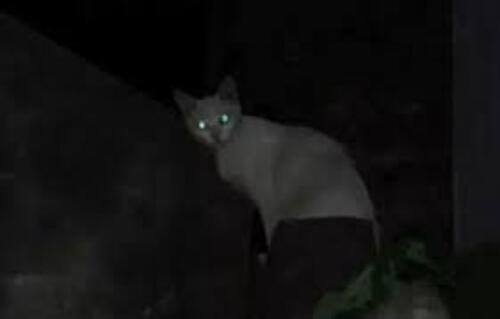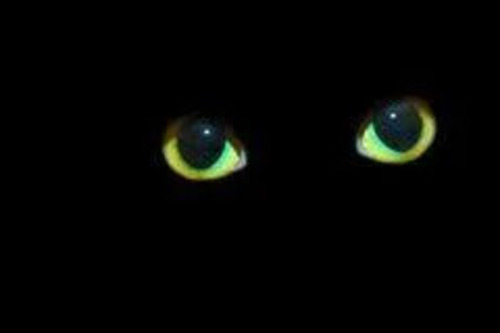The phenomenon of animals’ eyes glowing in the dark, particularly with a greenish hue, is a fascinating display of nature's adaptation to the night. This glow, known as eyeshine, is caused by the tapetum lucidum, a layer of tissue in the eye that reflects light and improves night vision. While eyeshine can appear in various colors depending on the animal and lighting conditions, green is one of the most common. Below, we will explore several animals whose eyes glow green at night, their habitats, protection status, and other interesting details.

Region: Worldwide, except for Antarctica.
Protection Status: Varies by species (Domestic cats are not endangered, but some wild species like the Amur leopard and snow leopard are critically endangered).
Description: Cats, both domestic and wild, are known for their glowing green eyes at night. This is because of the tapetum lucidum, which enhances their ability to see in low-light conditions. Wild species such as leopards, tigers, and lions exhibit this trait, helping them become more effective nocturnal hunters.
Region: Worldwide.
Protection Status: Varies by species (Domestic dogs are not endangered, but wild canids like the Ethiopian wolf are endangered).
Description: Like cats, dogs have a tapetum lucidum, giving them eyeshine that can appear green in certain lighting. This is more noticeable in breeds that have a strong predatory instinct or are used for nocturnal hunting. Wild dogs like wolves also show green eyeshine during nighttime activities.
Region: North America, Europe, Asia, and parts of Africa.
Protection Status: Varies by species (White-tailed deer are of least concern, but other species like the Père David’s deer are critically endangered).
Description: Deer are another common example of animals whose eyes glow green at night. Their large eyes are adapted to low-light environments, allowing them to forage safely in the dark. This trait is most noticeable when caught in headlights at night, where the green reflection from their eyes can be seen from a distance.
Region: North America.
Protection Status: Least concern.
Description: Raccoons are nocturnal scavengers and are often seen rummaging through garbage at night. Their eyeshine is usually a striking green, aiding them in finding food during dark hours. They possess excellent night vision, which is key to their survival in urban and forested areas.
Region: Worldwide, except for Antarctica.
Protection Status: Varies by species (Some, like the barn owl, are of least concern, while others, like the forest owlet, are critically endangered).
Description: Owls, being nocturnal hunters, have eyes that can exhibit green eyeshine. Their large eyes are designed to capture as much light as possible, making them highly effective predators of small mammals at night. Eyeshine is particularly noticeable in species with forward-facing eyes.
Region: North America, Europe, Asia, and parts of Africa.
Protection Status: Varies by species (Red foxes are of least concern, but some species like the Darwin's fox are endangered).
Description: Foxes, particularly red foxes, are known for their sharp nocturnal vision, and their eyes often reflect a greenish glow. This adaptation helps them navigate and hunt in the dark, where they rely on both their keen sight and other senses to locate prey.
Region: Africa, Australia, North America, South America, and parts of Asia.
Protection Status: Varies by species (The American alligator is of least concern, but some species like the Philippine crocodile are critically endangered).
Description: Crocodiles and alligators, being semi-aquatic predators, often exhibit green eyeshine. This makes them more efficient hunters during nighttime, when they are mostly active. The reflection helps them gauge the position of prey and navigate their swampy or riverine habitats.
Region: North America and parts of South America.
Protection Status: Least concern.
Description: Opossums, like raccoons, are nocturnal and have green eyeshine. This helps them forage for food in the dark, as they are omnivorous scavengers. Their strong nocturnal vision helps them evade predators and navigate complex environments, including urban areas.

The eerie glow of an animal's eyes at night, particularly the greenish hue, is a phenomenon known as eyeshine. This natural glow occurs in many nocturnal animals and is essential for their ability to see in low-light environments. While eyeshine can appear in various colors depending on the species, green is one of the most common. But why exactly do some animals' eyes glow green? Let’s dive into the science and anatomy behind this remarkable adaptation.

The key structure responsible for eyeshine is the tapetum lucidum, a reflective layer located behind the retina. Not all animals have this layer, but those that do are often nocturnal or crepuscular (active at dawn or dusk) and rely on it to enhance their night vision.
Tapetum Lucidum Function: The tapetum lucidum acts as a mirror, reflecting light that has passed through the retina back into the photoreceptor cells (rods and cones). This increases the amount of light available to the animal's visual system, giving them a second chance to absorb it. As a result, animals with a tapetum lucidum can see much better in dim lighting conditions than humans, who do not possess this reflective layer.
Why Green? The color of eyeshine varies between species and can be influenced by several factors, such as the structure and chemical composition of the tapetum lucidum. Green is a common eyeshine color in animals like cats, raccoons, and deer because of the particular way their tapetum lucidum reflects and scatters light. The green reflection is also influenced by the wavelength of the light source and the angle at which it hits the eye.
When light hits an animal’s eye at night, especially from a bright source like a flashlight or headlights, it enters the eye and passes through the retina. In species with a tapetum lucidum, the light then reflects off this layer, causing the eyes to glow. The reflective property is more pronounced in darkness because there’s less ambient light to diffuse the effect, making the glow more visible.
Retina and Light Absorption: After the light is reflected by the tapetum lucidum, it passes through the retina again, stimulating the photoreceptors. This makes these animals particularly adept at low-light vision, enhancing their ability to navigate or hunt in darkness.
Rods: Rods are photoreceptor cells in the retina responsible for vision in low-light conditions. They are extremely sensitive to light, but they do not detect color. In animals with a tapetum lucidum, the enhanced light exposure to the rods increases their ability to see in dim light, aiding in nocturnal activities.
Cones: Cones, on the other hand, are responsible for color vision and function best in bright light. While they are not as important for night vision, the reflection of light back into the eye also affects cones, though to a lesser degree.
Though green is a common color for eyeshine, it’s not the only one. The color of the eyeshine can vary depending on species, age, and even individual eye health. Other common colors include red, yellow, white, and blue. The following factors influence the specific color seen:
Species: Different species have different chemical compositions in their tapetum lucidum, affecting how light is reflected. For example, cats often have green eyeshine, while dogs may exhibit blue or greenish hues.
Age: Younger animals sometimes exhibit different eyeshine colors compared to adults. This is due to developmental changes in their eye structure and the density of reflective cells.
Health: The health of an animal's eye can also influence eyeshine. For instance, cataracts or other eye conditions may alter the reflective properties of the tapetum lucidum, changing the eyeshine color.
Humans lack a tapetum lucidum, which is why our eyes don’t glow green or any other color in the dark. Instead, when light is shone into our eyes, we sometimes see a red reflection, which is due to light bouncing off the blood vessels in the retina. This red-eye effect is most noticeable in flash photography and differs from the green or yellow eyeshine seen in many animals.
For nocturnal or crepuscular animals, having green or any color eyeshine is a crucial adaptation for survival. It significantly enhances their ability to see in low light, giving them an advantage in hunting, foraging, or evading predators during the night.
Night Hunters: Predators like cats and owls benefit greatly from eyeshine because it allows them to stalk and capture prey in near-total darkness. The green glow of their eyes is a sign of their exceptional low-light vision.
Prey Animals: Herbivores like deer and rabbits also possess eyeshine. Their green-glowing eyes help them detect predators even in low-light environments, making it easier for them to avoid danger at night.
The green glow of an animal's eyes at night is a fascinating adaptation that helps them thrive in darkness. This glow is caused by the tapetum lucidum, a reflective layer in the eye that enhances low-light vision. While green is a common color for eyeshine, the exact hue can vary depending on the species, age, and other factors. For animals like cats, dogs, deer, and raccoons, this ability to reflect light is an essential part of their nocturnal survival, allowing them to see in environments where humans would be virtually blind. Understanding the science behind eyeshine gives us a deeper appreciation of the ways animals have evolved to navigate and survive in the dark.
Animals that exhibit green eyeshine at night, such as cats, dogs, deer, and raccoons, share a common adaptation that helps them thrive in dark environments. This glow is a result of the tapetum lucidum, which improves their night vision, making them more efficient hunters or foragers. Understanding this phenomenon not only gives us insight into these animals' behavior but also highlights the incredible adaptations of nocturnal species across the world.
By learning about where these animals are found, their conservation status, and the reasons behind their glowing eyes, we gain a deeper appreciation of the fascinating ways nature has equipped creatures to survive and thrive in the dark.
animal tags: eyes
We created this article in conjunction with AI technology, then made sure it was fact-checked and edited by a Animals Top editor.